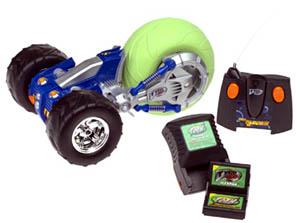Battle RC Air Rebound
Remote-controlled stunt toy.
 The Air Rebound is a remote-controlled stunt toy that's hard to describe but very easy to like. Imagine a futuristic 12-by-7-inch car body with no windows, no difference between top and bottom, and three tires, including one jumbo, neon green tire that measures 6.5 inches in diameter and 3.5 inches thick. Zoom it, turn it, jump it, flip it, and crash it--the Air Rebound doesn't seem to care about niceties like whether it's moving forward, backward, or upside down. Mere cars suddenly look pretty dull. The Air Rebound runs exclusively on a TMH Flexpak rechargeable battery system (included in this special bundle pack), but you'll also need a 9-volt battery (not included) to power the transmitter. The Air Rebound is available in two frequencies so you can stage races between vehicles with different frequencies. Before you can operate the vehicle, you'll need to use a pump (not included) to inflate the oversize green tire.
The Air Rebound is a remote-controlled stunt toy that's hard to describe but very easy to like. Imagine a futuristic 12-by-7-inch car body with no windows, no difference between top and bottom, and three tires, including one jumbo, neon green tire that measures 6.5 inches in diameter and 3.5 inches thick. Zoom it, turn it, jump it, flip it, and crash it--the Air Rebound doesn't seem to care about niceties like whether it's moving forward, backward, or upside down. Mere cars suddenly look pretty dull. The Air Rebound runs exclusively on a TMH Flexpak rechargeable battery system (included in this special bundle pack), but you'll also need a 9-volt battery (not included) to power the transmitter. The Air Rebound is available in two frequencies so you can stage races between vehicles with different frequencies. Before you can operate the vehicle, you'll need to use a pump (not included) to inflate the oversize green tire.
The Evolution of R/C Toy Stunt Vehicles
Radio-controlled (R/C) vehicles have captivated enthusiasts for decades. R/C stunt vehicles, in particular, bring an added level of excitement and dynamism, allowing users to perform tricks, flips, and jumps that typical R/C cars cannot. Here's a look at how these adrenaline-pumping toys have evolved over the years:
-
Origins:
- The earliest R/C vehicles, dating back to the mid-20th century, were basic in design and functionality, primarily geared towards forward and backward movement with simple turns.
- Stunt capabilities were not inherent but emerged as users modified their vehicles for better performance and tricks.
-
Design and Construction:
- Initial R/C cars were constructed from materials like metal and wood, making them heavier and limiting their stunt potential.
- As plastics and other lightweight materials became commonplace, the design of R/C stunt vehicles evolved, becoming more aerodynamic and flexible to withstand crashes and to perform stunts more efficiently.
-
Performance and Capabilities:
- Advancements in battery technology led to longer playtimes and greater power outputs, allowing for faster speeds and more daring stunts.
- Features like gyro-stabilization and advanced suspension systems made it easier to perform flips, wheelies, and spins.
- Some modern R/C stunt vehicles can even 'walk' on their large wheels or flip and continue driving when turned upside down.
-
Control Systems:
- Earlier R/C vehicles used basic radio frequency (RF) controls, often with limited range and responsiveness.
- Technological advancements led to the use of 2.4 GHz frequency systems, reducing interference and increasing the effective range of control.
- Some modern R/C stunt vehicles can be controlled using smartphone apps, offering customizable controls and even programmable stunts.
-
Terrain Adaptability:
- Initially, R/C cars were designed primarily for smooth surfaces or indoor play.
- Over time, R/C stunt vehicles have been equipped with durable tires, high-torque motors, and robust suspension systems, enabling them to tackle a variety of terrains, from smooth pavements to rough off-road tracks.
-
Aesthetic Appeal:
- Early R/C vehicles had a generic look. As the market expanded, manufacturers began to incorporate eye-catching designs, vibrant colors, and even LED lighting to add to the visual appeal of their stunt vehicles.
The evolution of R/C stunt vehicles showcases the blending of technology, design, and user demands. What began as simple, forward-driving toys has transformed into high-octane stunt machines capable of mesmerizing feats, providing hours of entertainment for both kids and adults.
